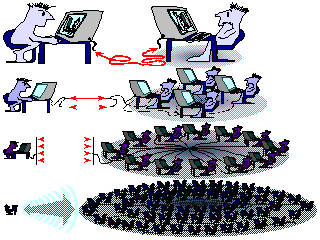
Fig. 4. (see bigger image)
4. General pattern of information interactions beyond theoretical limits
When an agent interacts with someone other he receives and keeps an information image of current partner's state.
Interaction between the observer and a certain given agent is possible in principle when the information image of this agent corresponds to his real state with sufficient accuracy. Two-way interaction between observer and given agent is possible when both information images can be maintaining correctly. If information image reproduces the state of the corresponding agent inaccurately, the possibility that this pair of agents will find a mutually acceptable variant of their joint activity based on some incorrect models is rather low.
Remember a picture from above of general limitations on the agent interactions within the information space. Following this the observer has realistic images of the agents when and only when the given agent group can adjust the frequency of changes in its information images on appropriate level. If the frequency of changes fits well to the possibilities of data transfer without losing information actuality to the distance from the observer to the agents then the observer will be able to interact with the agents.
Due to objective reasons an economic system has non-ideal level of current ICT development and some level of stochastic changes in the system. So it is always possible to find groups of agents within the space of a large-scale economic system that do not have technical means to organize information exchange at the level required for their interaction. Persistent stochastic changes in all the parts and objects of economic system devalue the content of information flows disseminated. With the given velocity of the changes in the state of agents requiring appropriate coordination with the partners, and limitations on the information dissemination velocity, it is always possible to determine the maximum distances within the system space exceeding which means technical impossibility of agent interaction. In previous sections this fact was a reason for selecting zones A, B, and C (see Fig. 3). However, by decreasing the necessity to coordinate the changes in their state the agents are able to organize interactions at the distances that exceed theoretically possible values. So if agents simultaneously slow down the level of their information image's changes, they will get conditions to interact each other in wider boundaries then before.
If information exchange level required for agent interactions cannot be attained by technical means (by changing information permeability of the environment), conditions necessary for the interaction can be created by institutional means. Agent can adopt behavior rules common for all of them; in accordance with the above their information images estranged to the outside environment, their information images should match certain standards. If the standards regulate the permissible upper limit of the degree of information image variability, then the set of agents that adhere to this standard, will form their own information images that will be uniform in their mutability extent. The totality of the latter uniform images can be considered as an independent sub-space for agent interaction; its content has certain relationship with the processes of change in the real space of economic system.
In fact, agents here should create a certain projection of real space. This projection has to differ from the reality in, at least, deceleration of the change processes. By designing institutional structures, agents can form projections of real space that reflect real processes with various decelerations. Each of these institutional limitations outlines the sub-spaces and makes for the establishment of new agent interaction conditions and channels. As a result, interactions become possible within broader spatial boundaries that would be unattainable without the use of appropriate institutional structures.
| From the point of view of individual agent-observer (see a man at the left side on Fig. 4), his interaction with variously remote groups of potential partners (one or many men at the right side on Fig. 4) requires him to design and maintain a whole set of his information images made to the standards of the corresponding sub-spaces. So the observer has several parallel channels and sub-space to interact with other agents (four parallel sub-spaces on Fig. 4). To make a set of his potential partners wider he has to simplify his information image according rules and standards of appropriate institutional structures. |
Fig. 4. (see bigger image) |
Thus, certain set of institutional structures operating in an economy, segments the entire space of the system into a certain number of sub-spaces with their own rules and parameters of agent interactions. The more remote interactions are to be organized, the higher deceleration of real processes is to be implemented when designing the corresponding sub-space.
In similar vein, the more remote interactions those sub-spaces are mediating, the stronger are the discrepancies between real processes in an economic system and their reflection in sub-spaces. It would be logical to assume that long-term functioning of these sub-spaces should be completed by a procedure of bringing the state of subspaces into accord with the real state of the economic system.
Now we have a general picture of context where information interactions take place. The next step is to describe a scheme of interactions in details.
Next section - 5. Scheme of Information Interactions: Causes and Motives of Interactions
Previous section - 3. Spatial boundaries of information interactions between agents